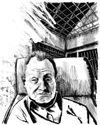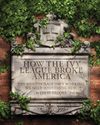
The city of Seville awoke early, the old streets alive with singing birds and distant bells.
The cobblestone alleys smelled faintly of hidden gardens. I'd flown here for a chance to hold a 480-year-old map in my hand. The archive's curators had given me no guarantees but said that I could come, in person, to make the request. For a century after Christopher Columbus, this town was the white-hot center of global exploration, teeming with sailors who'd been to the New World and returned to tell the tale. Now it was mellow and quaint.
I'd come researching my new book, The Barn, a history of the 36 square miles of dirt around the place where Emmett Till was tortured and killed in 1955. The barn, which I first wrote about for this magazine, sits in the southwestern quarter of Section 2, Township 22 North, Range 4 West, measured from the Choctaw Meridian. The township has been home to the civil-rights activist Fannie Lou Hamer; to the family of the Confederate general and early Ku Klux Klan leader Nathan Bedford Forrest; to farmland owned by James R. Binford, an original legal architect of Jim Crow.
It's borne witness to the creation of the blues at Dockery Plantation; to the erasure of a Native American community; and, of course, to the death of Till. With so much violent history in such proximity, this project almost inevitably became a mapping. That led me on a hunt for the very first map of this land, which was likely drawn in 1544 by a Spanish cartographer named Alonso de Santa Cruz. (There had been earlier maps of the North American shoreline, but none of the interior until this one.)
この記事は The Atlantic の October 2024 版に掲載されています。
7 日間の Magzter GOLD 無料トライアルを開始して、何千もの厳選されたプレミアム ストーリー、9,000 以上の雑誌や新聞にアクセスしてください。
すでに購読者です ? サインイン
この記事は The Atlantic の October 2024 版に掲載されています。
7 日間の Magzter GOLD 無料トライアルを開始して、何千もの厳選されたプレミアム ストーリー、9,000 以上の雑誌や新聞にアクセスしてください。
すでに購読者です? サインイン

The Dark Origins of Impressionism
How the violence and deprivation of war inspired light-filled masterpieces

The Magic Mountain Saved My Life
When I was young and adrift, Thomas Manns novel gave me a sense of purpose. Today, its vision is startlingly relevant.

The Weirdest Hit in History
How Handel's Messiah became Western music's first classic

Culture Critics
Nick Cave Wants to Be Good \"I was just a nasty little guy.\"

ONE FOR THE ROAD
What I ate growing up with the Grateful Dead

Teaching Lucy
She was a superstar of American education. Then she was blamed for the country's literacy crisis. Can Lucy Calkins reclaim her good name?

A BOXER ON DEATH ROW
Iwao Hakamada spent an unprecedented five decades awaiting execution. Each day he woke up unsure whether it would be his last.

HOW THE IVY LEAGUE BROKE AMERICA
THE MERITOCRACY ISN'T WORKING. WE NEED SOMETHING NEW.

Against Type
How Jimmy O Yang became a main character

DISPATCHES
HOW TO BUILD A PALESTINIAN STATE There's still a way.